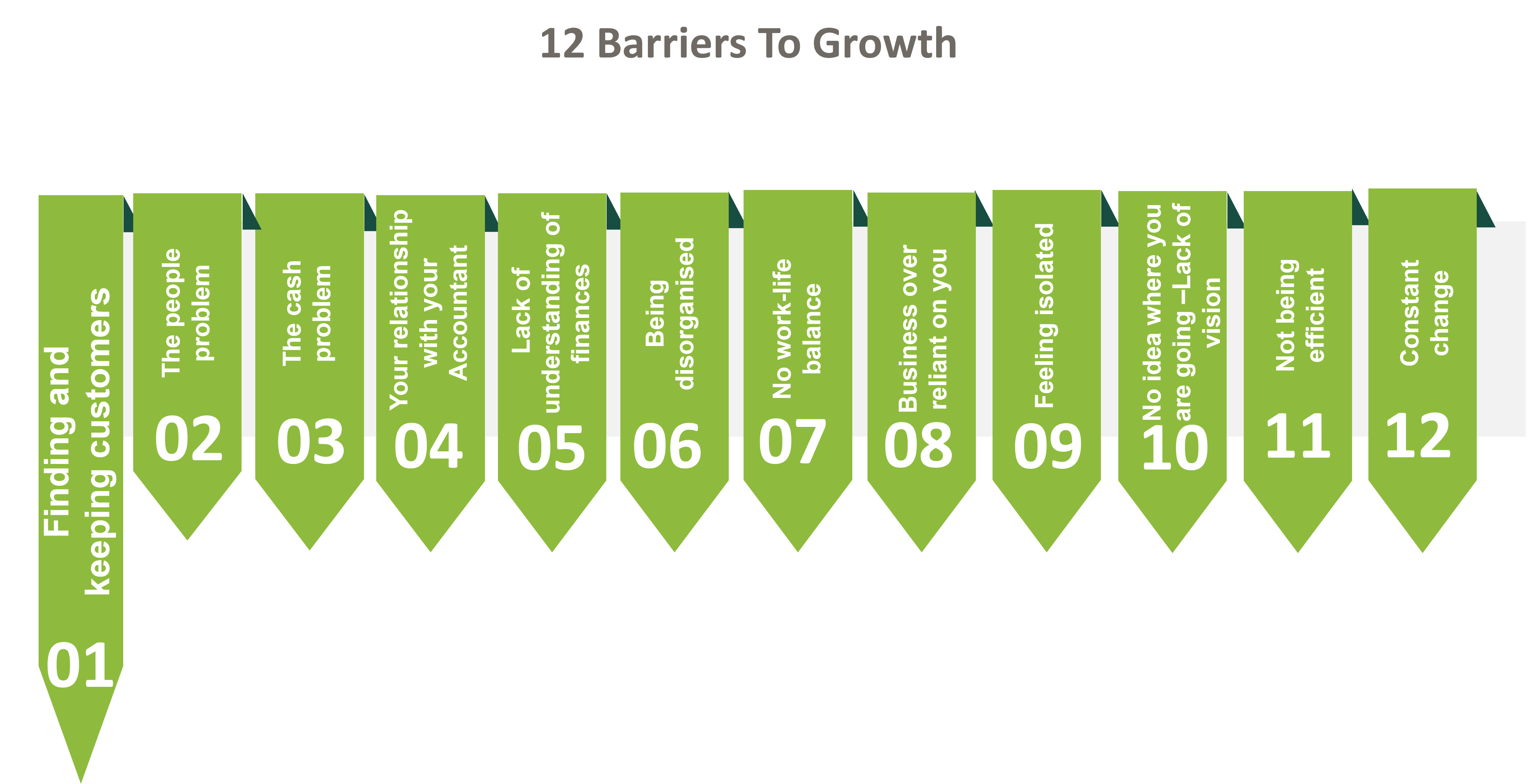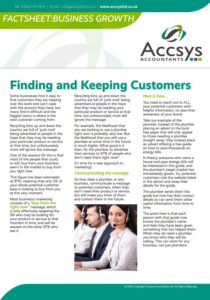Finding and Keeping Customers

Some businesses find it easy to find customers they are tripping over the work and can’t cope with the amount they have, but many find it difficult and the biggest worry is where is the next customer coming from.
Recycling bins up and down the country are full of ‘junk mail’ being advertised at people in the hope that they may be needing your particular product or service at that time, but unfortunately most will ignore the message.
One of the reasons for this is that most of the people that could, or will, buy from your business aren’t in the market to buy from you right now.
This figure has been estimated at 97%, meaning that only 3% of your whole potential customer base is looking to buy from you at this very moment.
Most business’s marketing consists of a “buy from me right now” message, which is only effectively targeting the 3% who may be looking for your product or service at that moment in time, and will be wasted on the other 97% who see it.
For example, the likelihood that you are looking to use a plumber right now is probably very low. But the likelihood that you will use a plumber at some time in the future is much higher. What good is it then, for the plumber to advertise their services to 97% of people who don’t need them right now?
It’s time for a new approach to marketing!
Communicating the message
So how does a plumber, or any business, communicate a message to potential customers, when they don’t need their product or service, but will make you think of them and contact them in the future.
Here is how…
You need to reach out to ALL your potential customers with helpful information, to raise their awareness of your brand.
Take our example of the plumber, instead of the plumber placing an advert in the local free paper that will only appeal to those needing a plumber straight away; they instead place an advert offering a free guide on how to save thousands on energy bills.
In theory, everyone who owns a house and pays energy bills will be interested in this guide, and the plumber’s target market has immediately grown. So, potential customers visit the website listed in the advert and swap their details for the guide.
The plumber sends them the guide but now has their contact details so can send them other useful information from time to time.
The point here is that each person with that guide now knows the plumber’s name and feels they have been given something that has helped them. When they do need a plumber, you know who they will be calling. This can work for any business, not just plumbers.
Maximising use of your website
Fundamentally a website is a way of providing information to the world. A business’s website has traditionally only been to give contact details and some basic information about your customers, but your website can offer so much more potential for attracting potential customers!
Firstly, the content of your website is the main thing that drives your listing on search engines such as Google. The more relevant the information on your website, the more likely people will find it when they are searching.
Google, for example, is all about connecting its users with relevant, useful information provided on the websites it indexes. Sections of free information or blogs contain a wealth of information that ensures your website is included in relevant searches.
Thinking back to the plumber example – what if they included on their website a section dedicated to helping homeowners fix minor problems, such as how to bleed a radiator, how to balance a system or how to unblock a toilet.
People searching for this information will be directed to the plumber’s website via the search engine, because it has picked up those keywords. Then when the job is more than this basic stuff, they will have that plumber in mind to call.
This information is relevant for every business whether your customers are businesses or consumers, so if you are not getting the results, you expect from your marketing, why not try something different.
So why aren’t more people doing it?
The reality of this is that it takes a bit more thought and a bit of planning and it’s much easier to stick an advert in the local free paper or advertiser. However, the people that are doing this and are getting above average results for a lower than average marketing spend.
Don’t forget your existing customers
As the saying goes “Make new friends but keep the old, one is silver the other is gold”. Existing customers are your goldmine they have an existing relationship with you and are happy with your business, so the barriers you have to overcome with new customers are gone. They are much easier to sell to.
So, are you selling to them? Do you have a system to stay in contact with your existing customers?
If you don’t regularly stay in contact with them with news and offers you are missing out on potential sales. You need to maintain contact with existing customers at all costs to keep the relationship alive.
One way to do this is via social media Facebook, Instagram etc. try to get them following you at the beginning of the relationship and keep them updated.
We hope this has short insight has inspired you to make some changes to your marketing approach. Marketing should be planned and pro-active.
Some businesses find it easy to find customers they are tripping over the work and can’t cope with the amount they have, but many find it difficult and the biggest worry is where is the next customer coming from.
Recycling bins up and down the country are full of ‘junk mail’ being advertised at people in the hope that they may be needing your particular product or service at that time, but unfortunately most will ignore the message.
One of the reasons for this is that most of the people that could, or will, buy from your business aren’t in the market to buy from you right now.
This figure has been estimated at 97%, meaning that only 3% of your whole potential customer base is looking to buy from you at this very moment.
Most business’s marketing consists of a “buy from me right now” message, which is only effectively targeting the 3% who may be looking for your product or service at that moment in time, and will be wasted on the other 97% who see it.
For example, the likelihood that you are looking to use a plumber right now is probably very low. But the likelihood that you will use a plumber at some time in the future is much higher. What good is it then, for the plumber to advertise their services to 97% of people who don’t need them right now?
It’s time for a new approach to marketing!
Communicating the message
So how does a plumber, or any business, communicate a message to potential customers, when they don’t need their product or service, but will make you think of them and contact them in the future.
Here is how…
You need to reach out to ALL your potential customers with helpful information, to raise their awareness of your brand.
Take our example of the plumber, instead of the plumber placing an advert in the local free paper that will only appeal to those needing a plumber straight away; they instead place an advert offering a free guide on how to save thousands on energy bills.
In theory, everyone who owns a house and pays energy bills will be interested in this guide, and the plumber’s target market has immediately grown. So, potential customers visit the website listed in the advert and swap their details for the guide.
The plumber sends them the guide but now has their contact details so can send them other useful information from time to time.
The point here is that each person with that guide now knows the plumber’s name and feels they have been given something that has helped them. When they do need a plumber, you know who they will be calling. This can work for any business, not just plumbers.
Maximising use of your website
Fundamentally a website is a way of providing information to the world. A business’s website has traditionally only been to give contact details and some basic information about your customers, but your website can offer so much more potential for attracting potential customers!
Firstly, the content of your website is the main thing that drives your listing on search engines such as Google. The more relevant the information on your website, the more likely people will find it when they are searching.
Google, for example, is all about connecting its users with relevant, useful information provided on the websites it indexes. Sections of free information or blogs contain a wealth of information that ensures your website is included in relevant searches.
Thinking back to the plumber example – what if they included on their website a section dedicated to helping homeowners fix minor problems, such as how to bleed a radiator, how to balance a system or how to unblock a toilet.
People searching for this information will be directed to the plumber’s website via the search engine, because it has picked up those keywords. Then when the job is more than this basic stuff, they will have that plumber in mind to call.
This information is relevant for every business whether your customers are businesses or consumers, so if you are not getting the results, you expect from your marketing, why not try something different.
So why aren’t more people doing it?
The reality of this is that it takes a bit more thought and a bit of planning and it’s much easier to stick an advert in the local free paper or advertiser. However, the people that are doing this and are getting above average results for a lower than average marketing spend.
Don’t forget your existing customers
As the saying goes “Make new friends but keep the old, one is silver the other is gold”. Existing customers are your goldmine they have an existing relationship with you and are happy with your business, so the barriers you have to overcome with new customers are gone. They are much easier to sell to.
So, are you selling to them? Do you have a system to stay in contact with your existing customers?
If you don’t regularly stay in contact with them with news and offers you are missing out on potential sales. You need to maintain contact with existing customers at all costs to keep the relationship alive.
One way to do this is via social media Facebook, Instagram etc. try to get them following you at the beginning of the relationship and keep them updated.
We hope this has short insight has inspired you to make some changes to your marketing approach. Marketing should be planned and pro-active.



